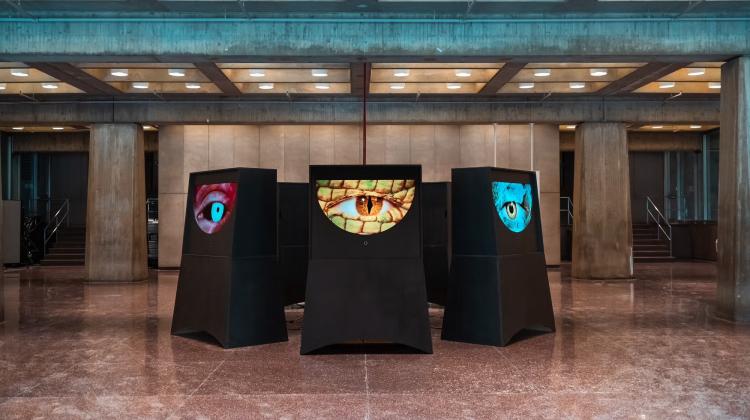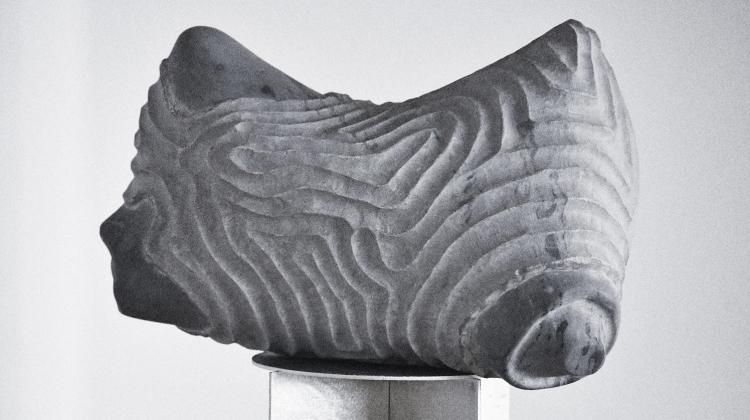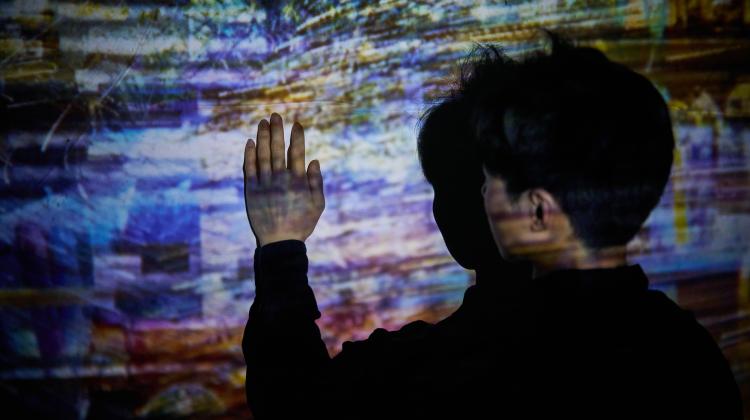The 2025 Harold and Arlene Schnitzer Prize in the Visual Arts

"Public Eyes" 2025 by Vinzenz Aubry is a generative video installation.

"Wave Finding — Jae, 2023" by Cheung Qin is a series of stone sculptures, each a vessel of memory, each asking for a reciprocal act of remembrance.

"Memory Still, 2025" by Chenyue "xxdd" Dai.
Three SA+P students are the recipients of the 2025 Schnitzer Prize in the Visual Arts, awarded for excellence in a body of work.
By Arts at MIT
The Council for the Arts at MIT congratulates the recipients of the 2025 Schnitzer Prize in the Visual Arts, awarded for excellence in a body of work.
Cheng Qin, Chenyue “xdd44” Dai, and Vinzenz Aubry are all artists who capture art’s enticing half-lives. Working in media that bridges the stone age with the space age, the three MIT student artists were recently named as winners of the 2025 Harold and Arlene Schnitzer Prize in the Visual Arts. Established in 1996 through the generosity of Harold and Arlene Schnitzer, the Schnitzer Prize is presented to current MIT students for excellence in a body of artistic work. Students submit a portfolio to be considered for the Schnitzer Prize. As graduate students, this year’s three winners will each receive an award of $5,000. Their work will be featured in a Wiesner Student Art Gallery show this May.
Vinzenz Aubry
Graduate Student, Art, Culture, and Technology program at MIT
Vinzenz Aubry SMACT ’25 already caught the public’s eye—or rather, his eyes caught the public—with Public Eyes, an interactive installation on display in the lobby of MIT Building 13 this spring as part of MIT’s campus-wide Artfinity Festival. The installation featured seven blocklike sculptures, deployed in a Stonehenge-like circle. Each sculpture had a digital screen displaying the eye of an alien creature. These eyes curiously looked at people as they moved across the lobby. “I wanted to renegotiate the idea of art in public spaces from a festival perspective,” says the artist. “And to question the gaze—these eyes that invite you—as a way to express curiosity, interest, and welcome.”
In Conjunktion, a nine-minute generative movie that changes each time it runs, Aubry trains a lens onto the sky to create a planetarium-like image that shows space trash instead of planets and stars. The film identifies constellations formed by various clusters of trash. “These objects are always present, but we usually can’t see them,” says Aubry. “This piece asks what meaning we might glean from examining them, what cultures might emerge in this totally man-made environment.”
Vinzenz Aubry is a French-German artist whose interdisciplinary practice explores process-based meaning-making among human-machine-nature relationships. Working at the intersection of art and technology, Aubry creates multi-sensory installations, sculptures, net art, and performances that manifest as time-based experiences, challenging traditional modes of spectatorship.
He currently pursues a master degree in Art, Culture and Technology at MIT and is a graduate in Media Art and Generative Art from the Berlin University of the Arts under Prof. Alberto de Campo and Prof. Joachim Sauter as well as the Tama Art University in Tokyo under Prof. Akihiro Kubota.
He has exhibited internationally at venues including Somerset House (UK), Monastery of São Martinho de Tibães (PT), Silent Green (DE) and Ars Electronica (AT). Notable recognitions include the Edigma Semibreve Award, DOK.Digital Prize, and finalist for the Grimme Online Award and Japanese Media Art Festival. Aubry teaches regularly at universities and has received scholarships from MIT, Media Lab Bayern and the German Ministry of Education and Research.
Cheng Qin
Masters candidate, Architecture
Cheng Qin MArch ’26 engages with one of humankind’s most ancient media: stone. Qin uses stone’s surfaces as his canvas, and its volume and mass as a metaphor for meaning. In The Dust between Our Nails and Fingertips, Qin uses an analog stone carving machine to etch handprints into a granite block; the handprints mimic the prehistoric handprints anthropologists find on mountain cliffs. “I wanted to see whether a mark made by a machine could elicit the same emotional gravity as a similar mark made by a human thousands of years ago,” he says.
For Wave Finding, Qin collected offcut stone blocks from quarries and construction sites and hand-etched patterns taken from weather and hydrological maps onto their surfaces. “The currents these maps describe, how the wind rises, how the water moves underground, are invisible to us,” he explains. “But we are still connected to them. In this work I’m trying to bring invisible movement and memory to the forefront.”
Cheng Qin (Cheung) is an interdisciplinary sculptor based in Cambridge, MA, with a background in architectural design, sculpture, and digital fabrication. His practice centers on creating actant instruments—inanimate artifacts or machines that autonomously perform and embody narratives of resilience. By pushing these artifacts beyond their static nature, his work explores fleeting, affective moments that exist between memory and speculation.
With professional experience as a design consultant for artist Sarah Oppenheimer and a designer for Olafur Eliasson, Cheung brings technical abilities to speculative design thinking. He was an artist in residence at Aalto Residency in Finland and at the Monopol School of Sculpture Berlin. His work has been exhibited internationally at institutions, including the Willem de Kooning Academie(Rotterdam), Yale’s SOA North Gallery, BCA Gallery(Shanghai), Dutch Design Week 2024, and MIT’s Wiesner Art Gallery.
Chenyue "xxdd" Dai
Masters candidate, architecture
Chenyue “xdd” Dai MArch ’26 makes art that spans the physical and digital realms. Working in photography, digital imagery, and even space design, the artist blurs the borders between transience and permanence. His portfolio includes designs for a deployable habitat for moon astronauts and a code-generated reflective metal and acrylic sculpture displayed atop a pedestal.
Dai as well—he likes to be called xdd—is acutely aware of the passage of time, and uses photography, computer vision algorithms, and AI to depict that passage. Unfamiliar Familiarity is a series of photo collages built on street scenes he photographed in Hong Kong. The images on display, however, are digital collages that fuse multiple images superimposed one atop the other. The result is an impressionistic surface that blurs recognizable elements while generating a sense of place in time through shapes, lights, and tones.
Hong Kong also figures prominently in Memory Still. Here, the artist takes digital images captured during a recent trip there and embeds them onto analog film. These digitally-generated analog frames are then projected onto a screen in a continuous loop. “I wanted to capture the temporal dissonance that defines contemporary Hong Kong,” he explains. “How the city, because of politics, remains unchanged while the rest of the world changes so rapidly.”
Chenyue “xdd” Dai is a programmer, photographer, and artistic designer. As a Master of Architecture student at MIT, he investigates visual spatial transformations that bridge the physical and digital realms, with a deep passion for photography and digital imagery. He also explores interactive systems and computational geometry across various media, with a strong belief that computational techniques can enhance creativity and push the boundaries of artistic and design practices.
Xdd has research and working experience at CityU ERFI Lab and Foster + Partners, and currently serves as research assistant at Media Lab’s Critical Matter group. Before coming to MIT, he earned a Bachelor’s degree in Computer Science from City University of Hong Kong, where he won multiple medals as a member of the university’s programming contest team.
Visit the Council for the arts at MIT for more information on the artists and their work.


